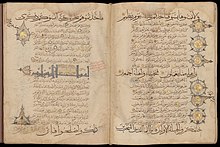Rayhani script

Yaqut al-Musta’simi. Baghdad, 1286/1287. Turkish and Islamic Arts Museum

Reyhan or Rayḥānī (
Arabic: ریحان) is one of the six canonical scripts of Perso-Arabic calligraphy. The word Reyhan means basil in Arabic and Persian. Reyhan is considered a finer variant of Muhaqqaq script, likened to flowers and leaves of basil.[1]
Rayḥānī was developed during the
Yaqut al-Musta’simi's method.[3]
References
- ^ "معرفی خط ریحان". golestane.net. Retrieved 1 September 2015.
- ^ الفخرو، إبراهيم بن يوسف (2015م). رحلة الخط العربي في ظلال المصحف الشريف (الطبعة الأولى). صفحة 100
- ^ Nassar Mansour Yaqut al-Musta’simi, Analytical Study of the Technical Characteristics of his Method in Rayhani Script, (in Arabic), 2018, Jordan Journal of History and Archaeology
